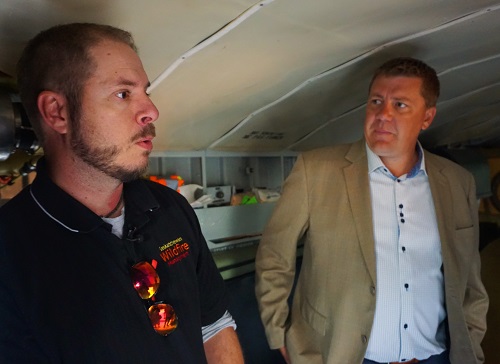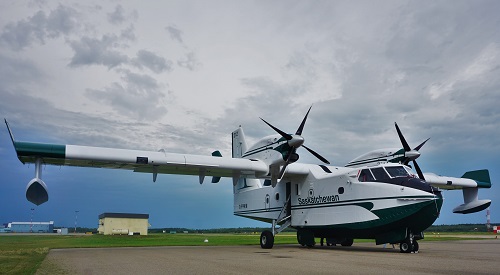Pilot Jeremy Hubka sits in the pilot seat of the CL-215T air tanker. Photo by Chelsea Laskowski.
Ever since Ian Stevenson was a kid, he wanted to fly the air tanker he’s standing in right now.
“I’ve chased this aircraft since I was 12 years old. I saw it at an airshow and I’ve wanted to fly it ever since. And now that I do, it’s a dream job for me,” he says at Prince Albert’s Air Tanker Base on July 21.
Today, he and fellow pilot Jeremy Hubka are touring media and Environment Minister Scott Moe through the CL-215T air tanker. It’s one of five behemoth CL-215Ts that just got cleared to fly in May after undergoing nine months of major upgrades and receiving $8.7 million in capital funding in this year’s provincial budget, and now the two pilots are explaining what drew them into this adrenaline-filled profession.
For Stevenson, plain and simple, it was the CL-215 model: “to fly this airplane, this is what I wanted to do. And I like fighting fire so I get to fly an airplane and fight a fire at the same time.”
For Hubka, who has lived in La Ronge for 28 years, it’s the landscape of the north that keeps him going.
“I love the north and the bush. I love landing on lakes, and that’s just what kept me doing it. I’m not into the airline thing. Flying from Calgary to Toronto back and forth, that kind of thing never really interested me so I like to be hands-on with an airplane and fly it instead of watching an autopilot control the airplane,” he says.
Both Hubka and Stevenson are based out of the Wildfire Management’s La Ronge branch for the summer, and today the CL-215T is the only one in the province’s fleet of CL-215Ts that’s grounded. The rest are off in Montana providing support during a busy forest fire season down south. Montana does not have anything like the CL-215, and there are only two like it in all of the United States, Moe says. Two of the larger air tankers and a bird dog are dedicated to BC right now, where wildfires are raging whereas Saskatchewan has only three current wildfires burning. In all, nine planes and 100 personnel are lent out of the jurisdiction as of today.
Ian Stevenson speaks with media while Minister Scott Moe looks on. Photo by Chelsea Laskowski.
For Stevenson, days like this – where he’s on the ground waiting for a call – are the hardest part of his job.
“This summer has been probably one of the most challenging because we’re just sitting, waiting for fires. Not that we want fires, but that’s our job and we’re trained to do so,” he says.
Sometimes even when there are fires blazing in Saskatchewan, it’s a hurry up and wait situation. Hubka recalls in 2015 when poor visibility from the smoke coming off the northern Saskatchewan wildfires kept pilots from getting into the sky.
But when they are cleared to launch into action, everything happens at a rapid-fire pace. A short flight to a new station can take 20 to 30 minutes, and once in action the amphibious newly modified CL-215T can drop 12,000 gallons of fire suppressant in an hour.
“When you get close to them, yup you’ll be flying through the smoke and smell it and feel the heat. Sometimes, if you get close enough to it you can feel the heat coming off,” Hubka says.
Aircraft like this are designed to load up from a body of water for their drops and in an average mission of six miles from water to fire, the CL-215T can complete ten drops in an hour.
The CL-215T on display at the Prince Albert’s Air Tanker Base on July 21, 2017. Photo by Chelsea Laskowski.
“My record, as of to date, is 88 pickups in just under a three-hour period. So it’s 88 take-offs, water drops, and landings,” Stevenson says, which prompts Moe to play reporter, asking how that compares to commercial pilots.
Hubka is sitting in the pilot’s seat and pipes up, saying “we do more landings in one day than an airline pilot’ll do in a year, with those busy fires.”
The newly modified CL-215T aircraft can dump 25 per cent more fire suppressant than its predecessor, the CL215. This is all thanks to new turbine engines to replace the propellers, and a lot of other upgrades that were finished earlier this year by BC company Cascade Aerospace Ltd. This was all budgeted for as part of a provincial three-year Wildfire Management plan that wraps up this year, Moe says, and the province has spent $28 million acquiring firefighting aircrafts over the past two years.
The water tanks are actually the same size, so it’s the aircraft’s newfound speed – a difference of 135 km/h “cruising” before to 324 km/h now, Hubka says – that increases the aircraft’s efficiency in firefighting.
Stevenson first took the new CL-215T out to fight a fire in Meadow Lake two weeks ago. Just yeserday, he and Hubka were at Wollaston Lake fighting a fire.
“It’s a lot faster and nicer. This machine” is more reliable, Hubka says.
Both Hubka and Stevenson will be relief for when the fire crews that are out in Montana and BC need to take a break, which typically takes a week or 10 days. Hubka says aside from a briefing once they land, there’s very little difference in how they do their jobs.
“The nice thing about going to Montana or BC or in a different area, so you’re getting to see some different terrain, meet some different people and see a different place,” he says.
For now, it’s hurry up and wait.


